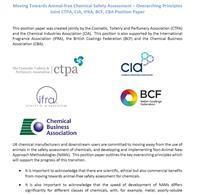This position paper was created jointly by the Cosmetic, Toiletry and Perfumery Association (CTPA) and the Chemical Industries Association (CIA). This position is also supported by the International Fragrance Association (IFRA), the British Coatings Federation (BCF) and the Chemical Business Association (CBA).
Download position paper
UK chemical manufacturers and downstream users are committed to moving away from the use of animals in the safety assessment of chemicals, and developing & implementing Non-Animal New Approach Methodologies (NAMs). This position paper outlines the key overarching principles which will support the progress of this transition.
- It is important to acknowledge that there are scientific, ethical but also commercial benefits from moving towards animal-free safety assessment for chemicals.
- It is also important to acknowledge that the speed of development of NAMs differs significantly for different classes of chemicals, with, for example, metal, poorly-soluble materials, Natural Complex Substances (NCS) and nanomaterials facing technical challenges that slow progress.
- The transition towards animal-free safety assessment for chemicals is a stepwise process and should occur gradually. However, it is key to put resources in place to accelerate the pace of scientific developments, global regulatory acceptance and business capability building and confidence for all parties.
- Any transition should take the global landscape into consideration. Therefore, cooperation at international level is vital to share best practice and knowledge, as well as to promote harmonisation and standardisation of methods and approaches between different global regions. This is crucial, considering that companies operate in global markets and supply chains.
- Collaboration between key stakeholders, for example industry, NGOs, academics, regulators, and ideally the Organization for Economic Co-operation & Development (OECD); recognising that it takes time to adopt an OECD Test Guideline is essential to build confidence amongst industry and reach regulatory acceptance. This collaboration will also boost confidence and help build capacity, because moving towards animal free safety assessment of chemicals is a collective effort. There should be a focus on developing clear criteria for adoption of NAMs and Next Generation Risk Assessment (NGRA) methods, because it is important to have a robust framework in place for their assessment. Ultimately, the assessment process needs to focus on building broader scientific confidence in the data and their interpretation.
- Relevant chemicals and sectorial legislation should be updated to introduce flexibility to incorporate the use of NAMs and NGRA approaches to meet regulatory requirements.
- Education and training play an essential role; in particular, practical training which builds confidence in applying NAMs and NGRA approaches to realistic scenarios.
- The development and uptake of NAMs and NGRA needs to be adequately funded by the Government. This should also consider a mode to make the deployment accessible to all industry sectors, including SMEs. It is important to consider that SMEs may not have significant resources to invest into the uptake of the non-animal NAMs and NGRA approaches.

Joint Associations NAMs transition principles paper
This position paper was created jointly by the Cosmetic, Toiletry and Perfumery Association (CTPA) and the Chemical Industries Association (CIA). This position is also supported by the International Fragrance Association (IFRA), the British Coatings Federation (BCF) and the Chemical Business Association (CBA).
DOWNLOADPDF | 201 Kb






















